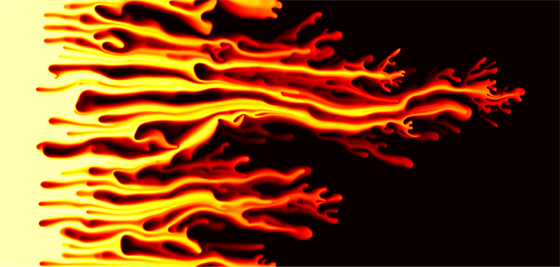
Snapshot of the concentration field during the unstable displacement of a more viscous fluid (dark) by a fully-miscible, less viscous fluid (light).
Image: Birendra Jha
Mixing fluids in small spaces is a big problem in many industries where introducing one fluid can help extract another, such as pumping water underground to release oil trapped in porous rock. Now, researchers in MIT’s Department of Civil and Environmental Engineering (CEE) say a simple new method may improve efficiency in oil recovery and other applications: fluids of different viscosity that combine to create “viscous fingers” able to induce efficient mixing in tight spaces.
“Getting two fluids to mix in a very tight space is difficult because there’s not much room for a disorderly flow,” says Ruben Juanes, the ARCO Associate Professor in Energy Studies at MIT and principal investigator on the research, which received funding from the Italian energy company Eni. “But with two fluids of highly contrasting viscosity, the thinner fluid naturally creates disorder, which proves to be a marvelously efficient means of mixing.”
The new technique might also be useful in microfluidics — the controlled manipulation of fluids in miniscule channels often only a few microns wide. Microfluidic technology was first introduced in the 1980s, and for many years was best known for its use in ink-jet printers. The devices are now used in many other fields, including in the chemical analysis of blood or other sera in lab-on-a-chip technologies.
In an analysis published online May 12 in Physical Review Letters (PRL), the MIT researchers showed that the injection of a thin, or low-viscosity, fluid into a more viscous fluid — think of water spurting into molasses — will cause the two fluids to mix very quickly via a physical process known as viscous fingering. The thinner liquid, the researchers say, will form fingers as it enters the thicker liquid, and those fingers will form other fingers — and so on until the two liquids have mixed uniformly.
Juanes and his colleagues also found that for maximum mixing to occur quickly, the ideal ratio of the viscosity of any two fluids depends on the speed at which the thinner liquid is injected into the thicker one. On average, the viscosity of the fluid injected should be about 10 times lower than that of the fluid into which it is injected. If the contrast is greater than 10, then the injection should be done more slowly to achieve good mixing. Otherwise, the low viscosity fluid will create a single channel through the thicker fluid.
To test this theory, Juanes, CEE postdoc Luis Cueto-Felgueroso and graduate students Birendra Jha and Michael Szulczewski conducted a series of experiments using mixtures of water and glycerol, a colorless liquid generally about 1,000 times more viscous than water. After alternating the viscosity ratio of the fluids and the velocity of the injection flow, Jha was able to develop a mathematical model characterizing the rate at which the fluids mix. The researchers then used that model to determine the best viscosity ratio for a particular velocity. Jha is lead author on the PRL paper.
“It’s been known for a very long time that a low-viscosity fluid will finger through the high-viscosity fluid,” Juanes says. “What was not known is how this affects the mixing rate of the two fluids. For instance, in the petroleum industry, people have developed increasingly refined models of how quickly the low-viscosity fluid will reach the production well, but know little about how it will mix once it makes contact with the oil.”
Professor Martin Blunt, head of the Department of Earth Science and Engineering at Imperial College London, said this is indeed the case. “Viscous fingering is well-established as a fascinating and important flow phenomenon in enhanced oil recovery and a host of other natural and engineered processes. While the process has been studied in the laboratory and simulated numerically, there has been no rigorous treatment of the complex interplay of flow and diffusion and no quantitative understanding of the fluid mixing that results,” Blunt says. “This seminal paper by Professor Ruben Juanes and co-workers at MIT places the treatment of mixing in viscous fingering on a firm theoretical foundation, backed up by extensive numerical simulation, exploiting techniques hitherto used to study turbulent flows.”
Juanes said that similarly, the use of fluids of different viscosities has not been seriously proposed as a mixing mechanism in microfluidics technology, but the new study indicates it could work very efficiently in the miniscule channels of these devices.
“Mixing fluids at the small scales of microfluidic devices is difficult because you can’t rely on turbulence; it would be hard to stir milk into your coffee if you were using a microscopic cup,” Cueto-Felgueroso says. “With viscous fingering, you let the fluids do the job of stirring.”






